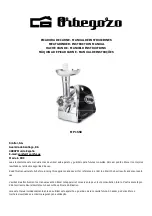
7 ENGLISH
For example, if an abrasive wheel is snagged or
pinched by the workpiece, the edge of the wheel that is
entering into the pinch point can dig into the surface of
the material causing the wheel to climb out or kick out.
The wheel may either jump toward or away from the
operator, depending on direction of the wheel’s move
-
ment at the point of pinching. Abrasive wheels may also
break under these conditions.
Kickback is the result of power tool misuse and/or
incorrect operating procedures or conditions and can be
avoided by taking proper precautions as given below.
1.
Maintain a firm grip on the power tool and
position your body and arm to allow you to
resist kickback forces. Always use auxiliary
handle, if provided, for maximum control over
kickback or torque reaction during start-up.
The operator can control torque reactions or kick
-
back forces, if proper precautions are taken.
2.
Never place your hand near the rotating acces
-
sory.
Accessory may kickback over your hand.
3.
Do not position your body in the area where
power tool will move if kickback occurs.
Kickback will propel the tool in direction opposite
to the wheel’s movement at the point of snagging.
4.
Use special care when working corners, sharp
edges etc. Avoid bouncing and snagging the
accessory.
Corners, sharp edges or bouncing
have a tendency to snag the rotating accessory
and cause loss of control or kickback.
5.
Do not attach a saw chain woodcarving blade
or toothed saw blade.
Such blades create fre
-
quent kickback and loss of control.
Safety Warnings Specific for Grinding Operation:
1.
Use only wheel types that are recommended
for your power tool and the specific guard
designed for the selected wheel.
Wheels for
which the power tool was not designed cannot be
adequately guarded and are unsafe.
2.
The grinding surface of centre depressed
wheels must be mounted below the plane of
the guard lip.
An improperly mounted wheel that
projects through the plane of the guard lip cannot
be adequately protected.
3.
The guard must be securely attached to the
power tool and positioned for maximum safety,
so the least amount of wheel is exposed
towards the operator.
The guard helps to protect
the operator from broken wheel fragments, acci
-
dental contact with wheel and sparks that could
ignite clothing.
4.
Wheels must be used only for recommended
applications. For example: do not grind with
the side of cut-off wheel.
Abrasive cut-off wheels
are intended for peripheral grinding, side forces
applied to these wheels may cause them to
shatter.
5.
Always use undamaged wheel flanges that are
of correct size and shape for your selected
wheel.
Proper wheel flanges support the wheel
thus reducing the possibility of wheel breakage.
Flanges for cut-off wheels may be different from
grinding wheel flanges.
6.
Do not use worn down wheels from larger
power tools.
Wheel intended for larger power tool
is not suitable for the higher speed of a smaller
tool and may burst.
Additional Safety Warnings:
1.
When using depressed centre grinding wheels,
be sure to use only fiberglass-reinforced
wheels.
2.
NEVER USE Stone Cup type wheels with this
grinder.
This grinder is not designed for these
types of wheels and the use of such a product
may result in serious personal injury.
3.
Be careful not to damage the spindle, the
flange (especially the installing surface) or the
lock nut. Damage to these parts could result in
wheel breakage.
4.
Make sure the wheel is not contacting the
workpiece before the switch is turned on.
5.
Before using the tool on an actual workpiece,
let it run for a while. Watch for vibration or
wobbling that could indicate poor installation
or a poorly balanced wheel.
6.
Use the specified surface of the wheel to per
-
form the grinding.
7.
Do not leave the tool running. Operate the tool
only when hand-held.
8.
Do not touch the workpiece immediately after
operation; it may be extremely hot and could
burn your skin.
9.
Do not touch accessories immediately after
operation; it may be extremely hot and could
burn your skin.
10.
Observe the instructions of the manufacturer
for correct mounting and use of wheels.
Handle and store wheels with care.
11.
Do not use separate reducing bushings or
adaptors to adapt large hole abrasive wheels.
12.
Use only flanges specified for this tool.
13.
For tools intended to be fitted with threaded
hole wheel, ensure that the thread in the wheel
is long enough to accept the spindle length.
14.
Check that the workpiece is properly
supported.
15.
Pay attention that the wheel continues to
rotate after the tool is switched off.
16.
If working place is extremely hot and humid,
or badly polluted by conductive dust, use a
short-circuit breaker (30 mA) to assure opera
-
tor safety.
17.
Do not use the tool on any materials contain
-
ing asbestos.
18.
Do not use cloth work gloves during operation.
Fibers from cloth gloves may enter the tool, which
causes tool breakage.
SAVE THESE INSTRUCTIONS.
WARNING:
DO NOT let comfort or familiarity
with product (gained from repeated use) replace
strict adherence to safety rules for the subject
product. MISUSE or failure to follow the safety
rules stated in this instruction manual may cause
serious personal injury.








































